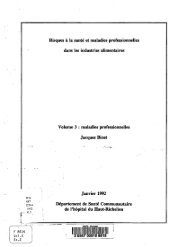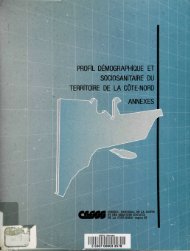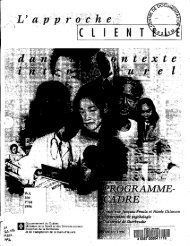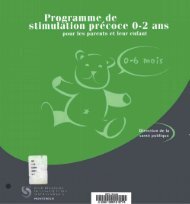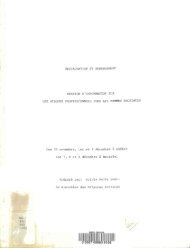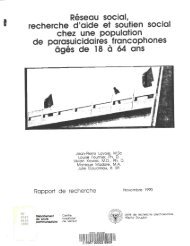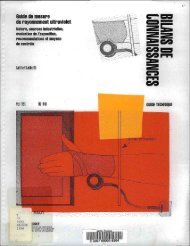le travail à l'écran de visualisation work with display units
le travail à l'écran de visualisation work with display units
le travail à l'écran de visualisation work with display units
Create successful ePaper yourself
Turn your PDF publications into a flip-book with our unique Google optimized e-Paper software.
COMPUTERIZED OFFICE TECHNOLOGY AND VISUAL IMPAIRMENT:COMMUNICATION, ATTITUDES,AND EXPERIENCESErland Hjelmquist and Bengt JanssonDepartment of Psychology, University of GôteborgBox 14158, S-400 20 Goteborg, Swe<strong>de</strong>nOffice automation usually inclu<strong>de</strong>s all or some of the following stages:Planning, piloting, imp<strong>le</strong>mentation of hardware, and integration of thecomputer system in the job routines. During two years a 'multimedia office',where a particular feature was a relatively large number of blind or weaksighted employees, has been un<strong>de</strong>r study during all stages but the last one.The office automation so far only concerns word processing. The primarypurpose was to facilitate the communication between blind and sighted persons.The present report focuses on the imp<strong>le</strong>mentation stage. The primary questionsaddressed were influences on communication patterns, attitu<strong>de</strong>s to thetechnique, subjective evaluations of usage of the equipment, and jobexpectati ons in the short and long run, as an effect of use of computers.Procedure. Seventeen secretaries, and 3 blind or visually impairedadministrators participated in the study. The secretaries were successivelyprovi<strong>de</strong>d <strong>with</strong> personal computers. The computers were equipped <strong>with</strong> a wordprocessor, speech synthesis, and a conversion program for a brail<strong>le</strong> printer.The two blind persons used a versabrail<strong>le</strong> machine, whi<strong>le</strong> the third weaksighted person used a personal computer (<strong>with</strong> another operation system thanthe one the secretaries used) <strong>with</strong> speech synthesis. Data were col<strong>le</strong>cted <strong>with</strong>interviews and questionnaires at three occasions.Results. The visually impaired persons received to a higher <strong>de</strong>gree writtenmaterial. However, converting tabulated text to brail<strong>le</strong> print caused difficultprob<strong>le</strong>ms. The secretaries approved of the facilities of word processing. Onthe other hand, many of the secretaries stated that they experienced morestress due to use of computers. Some of them also stated that they got toolitt<strong>le</strong> support when prob<strong>le</strong>ms arose <strong>with</strong> word processing. Furthermore, it wasfound that a richer usage of word processor functions correlated <strong>with</strong>different general positive attitu<strong>de</strong>s to usage of computers.The imp<strong>le</strong>mentation of computers influenced the communication patterns of theparticipants, but marginally. With exception of the most important aspect,viz that visually impaired persons received more written information,contacts concerned different prob<strong>le</strong>ms <strong>with</strong> word processing and the brail<strong>le</strong>print(ers). Moreover, during <strong>work</strong> breaks participants discussed the computerusage to some extent. However, these discussions seemed to <strong>de</strong>crease. Thus, theimp<strong>le</strong>mentation of computers did not result in creating new, or loosingprevious job contacts.Despite positive effects, several persons pointed to the specificcircumstances in a 'multimedia office'. They stressed the importance ofsolving prob<strong>le</strong>ms of a minor imp<strong>le</strong>mentation before large sca<strong>le</strong> imp<strong>le</strong>mentationtake place.KEYWORDS: Blindness, media conversion, communicationUSER PERFORMANCE AND ERROR ANALYSIS:COMPUTER BASED NEWSPAPER READING BY BLIND PEOPLEErland Hjelmquist and Bengt JanssonDepartment of Psychology, University of GôteborgBox 14158, S-400 20 GSteborg, Swe<strong>de</strong>nDuring a number of years we have been involved in studies of blindpeop<strong>le</strong>'sreading of speech synthesized daily morning papers. In this report we winconcentrate on error analysis of used commands.The blind users are not expected to have any previous experience <strong>with</strong>computers, therefore it is important that the command giving is conce<strong>de</strong>d ofas simp<strong>le</strong>.About 30 commands are availab<strong>le</strong> to the rea<strong>de</strong>r. If thecharacters which do not match the pre-programmed commands the system gives anerror message <strong>with</strong>out explication.Procedure The analysis of errors is based on usage log of 50 blind persons^ t h none or litt<strong>le</strong> previous experience of computers. The age range wasbetween 20-80 years.The erroneous commands (ERROR) given by the users were studied <strong>with</strong> multip<strong>le</strong>regression. The following components were treated as explaining variabiLes;•Reading aspects (amount, time, speed), command aspects (<strong>le</strong>ngth ofrespectively time to enter commands, number of given movement commands in thehorizontally and vertically organized newspaper), system aspects (waiting timefor execution of commands, number of daily starts of the system).The command giving has also been studied sequentially (allcommands). For each user the commands have been organized m a Markov chain.Results. About 5% of the commands given by the users were not £Ï^tST The multip<strong>le</strong> (stepwise) regression showed that 3 P RE * XCT °significantly influenced ERROR. These predictors explained 75% of thevariance.The most important predictor concerned the number of daily starts of thesystem (resets). Daily restarts of the system indicate a usage characterizedby many, but short sessions. The next most important predictor concerned thes eT^f entering cormnands on the brail<strong>le</strong> keyboard. Thisto misspellings. Finally, users that more often moved around in thtext basema<strong>de</strong> more erroneous commands. Especially movements other than forwardmovements caused errors, probably due to orientation prob<strong>le</strong>ms m thehierarchically structured text base.The sequential analysis showed that erroneous commands in 35% of the caseswere followed by the same or other erroneous commands. Furthermore, m It ofthe cases erroneous commands were solved by reset of the system. The findingsare interesting from a general psychological point of view, and from apractical point of view they indicate a need for a help system.KEYWORDS: Blindness, newspapers, error analysisTEV 1989 —DEUXIÈME CONFÉRENCE SCIENTIFIQUE INTERNATIONALE • MONTRÉAL • SECOND INTERNATIONAL SCIENTIFIC CONFERENCE — WWDU144TEV 1989 - DEUX.ÈME CONFÉRENCE S O ^ I ^ N T E I ^ ^ • SECOND INTERNATIONAL SCIENTIFIC CONFERENCE WWDU 1989145



